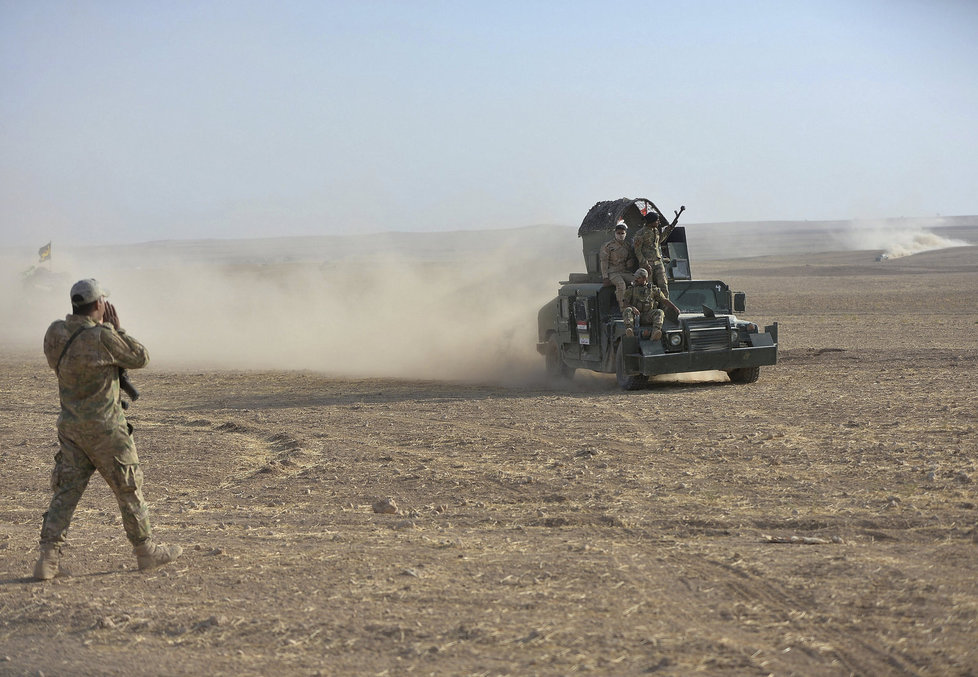Mosul- Kurdish Peshmerga fighters have reportedly killed 16 ISIS hardliners in Bashiqa, Nineveh. The militants had been staying at a city hideout, awaiting the opportunity to make it past Peshmerga checkpoints to join the fight in Mosul.
Iraqi Security Forces units of the 9th Armored Division made an advance towards villages of Abbas Rajab and Al-Nomaniyah, toward Nimrud, the Joint Operations Command said, later announcing that Abbas Rajab had been officially retaken.
Nimrud was the one of the great centers of the ancient Middle East. Founded in the 13th century BC, it became the capital of the Assyrian empire, whose rulers built vast palaces and monuments that have drawn archaeologists for more than 150 years.
Karemlash, an ancient Assyrian town in northern Iraq located less than 29 Kilometers south east of Mosul, recently freed of ISIS-hold by the ISF, has been turned into a minefield.
As Asharq Al-Awsat reporters attempted taking a tour of the former ISIS stronghold, they were accompanied by army detail for both security and guidance.
The dislodged terror group had randomly planted explosive mines throughout the town. Before the ISIS takeover in summer 2014, Karemlash was considered one of the most beautiful towns of Nineveh’s valley in Iraqi Kurdistan.
Villages recaptured from ISIS over the past three weeks by the Kurdish Peshmerga and Iraqi army forces on the road to Mosul have been honeycombed with tunnels, many of them booby-trapped.
ISIS militants had dug an entire network of underground tunnels, which have been used as a safety bunker from coalition air raids – more so the underground passages were also a part of the hardliners’ street fighting strategy against ISF units.
Although ISIS extremists had been successfully driven out of Mosul’s Karemlash, they had left the town in a regrettable and hazardous state. The once Iraqi attraction had been close to burnt to the ground with all the fighting, not to mention the arbitrary minefields that make it all the less safe for civilian life’s immediate return.
In the past three days, commanders say Iraqi forces have faced the hardest fighting of the offensive as they entered Mosul, made worse by extensive tunnels that are allowing ISIS fighters to appear seemingly out of nowhere, attack, then retreat to the hidden bunkers.
ISIS didn’t invent the tactic. Tunnels have been used in warfare for thousands of years, especially valued in asymmetric guerilla war.
In Karemlash, Iraqi Christian militias uncovered cramped earthen burrows used by ISIS fighters to hide from surveillance drones, artillery shells and US-led airstrikes.
The tunnels were dug into a hill that covers an archaeological site of an ancient Assyrian city.
ISIS also commandeered the Saint Barbara convent and dug deep tunnels through the floor of the chapel. The village marks the site where Alexander the Great fought the Persian emperor Darius in 331BC.
Some tunnels go for hundreds of meters. The earth is hard-packed and laced with rocks and the passageways illuminated with electric lights. Iraqi troops have found weapon caches, small kitchens, food pantries and rooms stacked with explosives.
To conceal their digging from drones and satellites, ISIS fighters usually hid the soil.
The longest tunnel discovered so far stretched for almost 10km at the edge of Mosul, according to Iraqi commanders, dug by ISIS cadres with help from civilians probably forced to shovel.
